NSB202: Indigenous Population Healthcare in Australia Analysis Report
VerifiedAdded on 2022/11/15
|7
|2127
|87
Report
AI Summary
This report delves into the critical aspects of Indigenous healthcare in Australia, emphasizing the health disparities faced by Aboriginal and Torres Strait Islander populations. It examines the "Closing the Gap" strategy, a government initiative aimed at reducing health inequalities, and contrasts it with the "Close the Gap" campaign, a social justice movement. The report analyzes the impact of funding on health outcomes, highlighting discrepancies in resource allocation and the need for equitable distribution. It further explores the significance of patient escort services in improving access to healthcare and discusses the vital role of Aboriginal/Indigenous hospital liaison officers in fostering cultural safety, providing patient support, and bridging communication gaps between patients and healthcare providers. The report concludes by emphasizing the importance of these strategies in improving the overall health status of Indigenous Australians and achieving health equity.
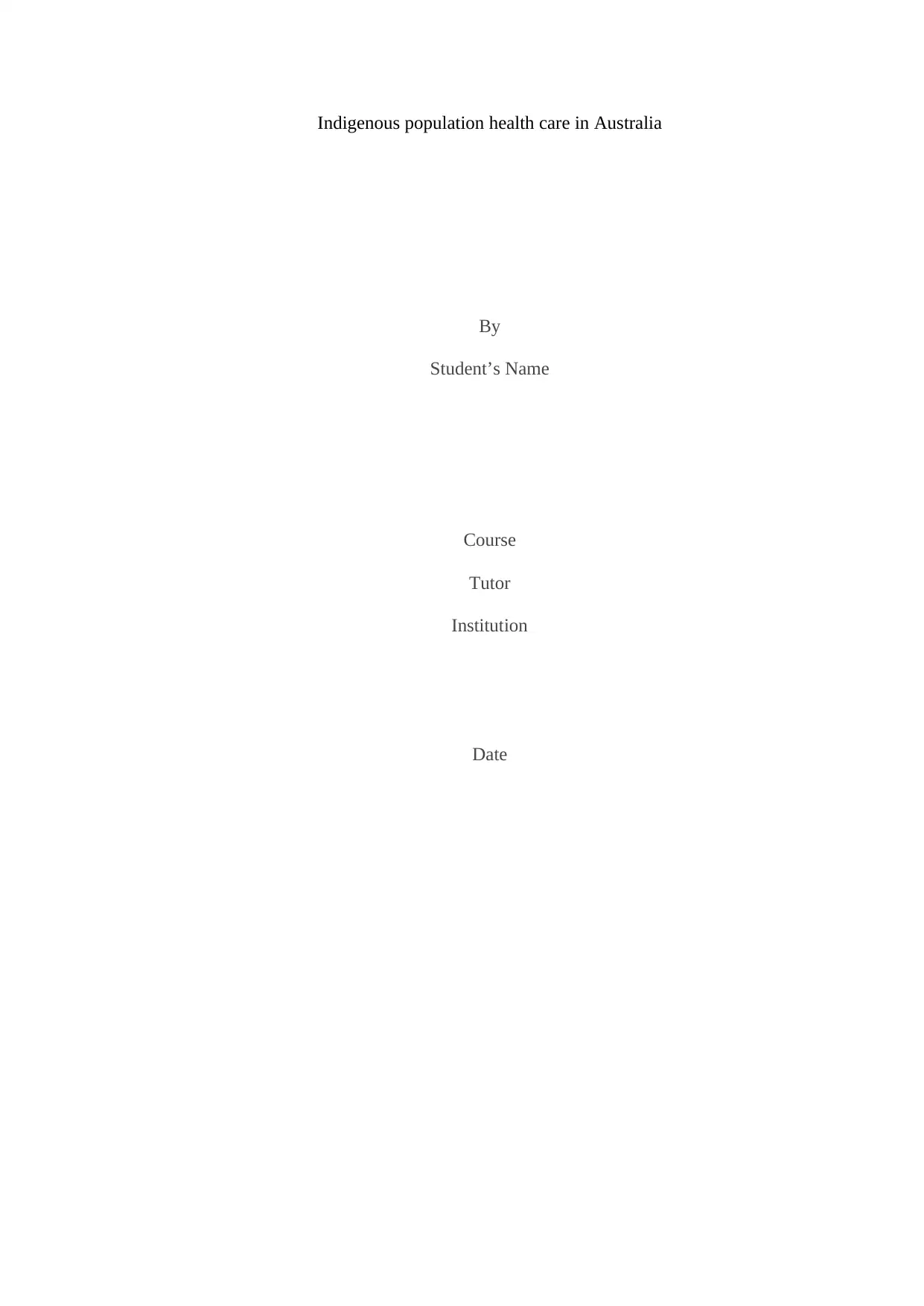
Indigenous population health care in Australia
By
Student’s Name
Course
Tutor
Institution
Date
By
Student’s Name
Course
Tutor
Institution
Date
Paraphrase This Document
Need a fresh take? Get an instant paraphrase of this document with our AI Paraphraser
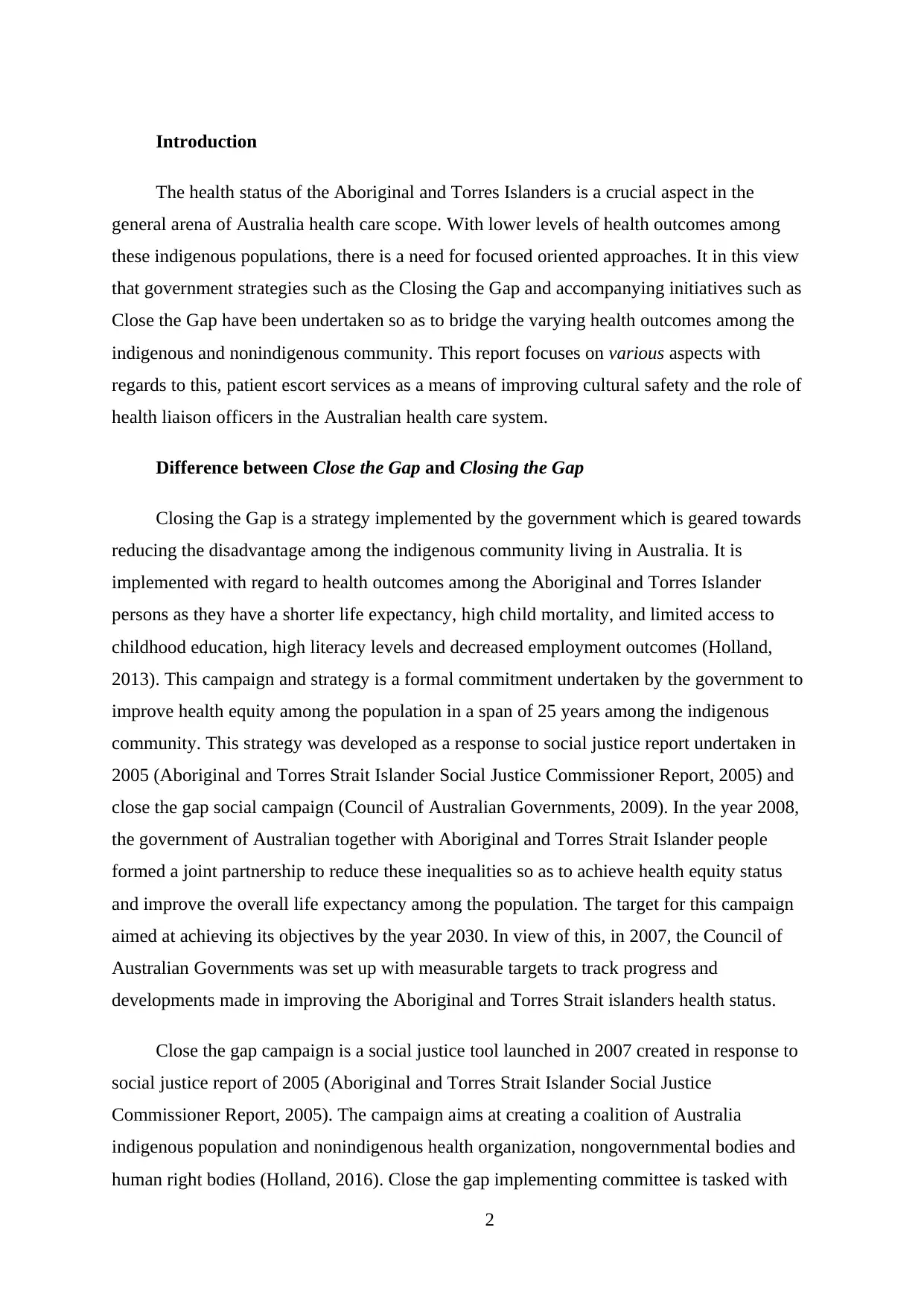
Introduction
The health status of the Aboriginal and Torres Islanders is a crucial aspect in the
general arena of Australia health care scope. With lower levels of health outcomes among
these indigenous populations, there is a need for focused oriented approaches. It in this view
that government strategies such as the Closing the Gap and accompanying initiatives such as
Close the Gap have been undertaken so as to bridge the varying health outcomes among the
indigenous and nonindigenous community. This report focuses on various aspects with
regards to this, patient escort services as a means of improving cultural safety and the role of
health liaison officers in the Australian health care system.
Difference between Close the Gap and Closing the Gap
Closing the Gap is a strategy implemented by the government which is geared towards
reducing the disadvantage among the indigenous community living in Australia. It is
implemented with regard to health outcomes among the Aboriginal and Torres Islander
persons as they have a shorter life expectancy, high child mortality, and limited access to
childhood education, high literacy levels and decreased employment outcomes (Holland,
2013). This campaign and strategy is a formal commitment undertaken by the government to
improve health equity among the population in a span of 25 years among the indigenous
community. This strategy was developed as a response to social justice report undertaken in
2005 (Aboriginal and Torres Strait Islander Social Justice Commissioner Report, 2005) and
close the gap social campaign (Council of Australian Governments, 2009). In the year 2008,
the government of Australian together with Aboriginal and Torres Strait Islander people
formed a joint partnership to reduce these inequalities so as to achieve health equity status
and improve the overall life expectancy among the population. The target for this campaign
aimed at achieving its objectives by the year 2030. In view of this, in 2007, the Council of
Australian Governments was set up with measurable targets to track progress and
developments made in improving the Aboriginal and Torres Strait islanders health status.
Close the gap campaign is a social justice tool launched in 2007 created in response to
social justice report of 2005 (Aboriginal and Torres Strait Islander Social Justice
Commissioner Report, 2005). The campaign aims at creating a coalition of Australia
indigenous population and nonindigenous health organization, nongovernmental bodies and
human right bodies (Holland, 2016). Close the gap implementing committee is tasked with
2
The health status of the Aboriginal and Torres Islanders is a crucial aspect in the
general arena of Australia health care scope. With lower levels of health outcomes among
these indigenous populations, there is a need for focused oriented approaches. It in this view
that government strategies such as the Closing the Gap and accompanying initiatives such as
Close the Gap have been undertaken so as to bridge the varying health outcomes among the
indigenous and nonindigenous community. This report focuses on various aspects with
regards to this, patient escort services as a means of improving cultural safety and the role of
health liaison officers in the Australian health care system.
Difference between Close the Gap and Closing the Gap
Closing the Gap is a strategy implemented by the government which is geared towards
reducing the disadvantage among the indigenous community living in Australia. It is
implemented with regard to health outcomes among the Aboriginal and Torres Islander
persons as they have a shorter life expectancy, high child mortality, and limited access to
childhood education, high literacy levels and decreased employment outcomes (Holland,
2013). This campaign and strategy is a formal commitment undertaken by the government to
improve health equity among the population in a span of 25 years among the indigenous
community. This strategy was developed as a response to social justice report undertaken in
2005 (Aboriginal and Torres Strait Islander Social Justice Commissioner Report, 2005) and
close the gap social campaign (Council of Australian Governments, 2009). In the year 2008,
the government of Australian together with Aboriginal and Torres Strait Islander people
formed a joint partnership to reduce these inequalities so as to achieve health equity status
and improve the overall life expectancy among the population. The target for this campaign
aimed at achieving its objectives by the year 2030. In view of this, in 2007, the Council of
Australian Governments was set up with measurable targets to track progress and
developments made in improving the Aboriginal and Torres Strait islanders health status.
Close the gap campaign is a social justice tool launched in 2007 created in response to
social justice report of 2005 (Aboriginal and Torres Strait Islander Social Justice
Commissioner Report, 2005). The campaign aims at creating a coalition of Australia
indigenous population and nonindigenous health organization, nongovernmental bodies and
human right bodies (Holland, 2016). Close the gap implementing committee is tasked with
2
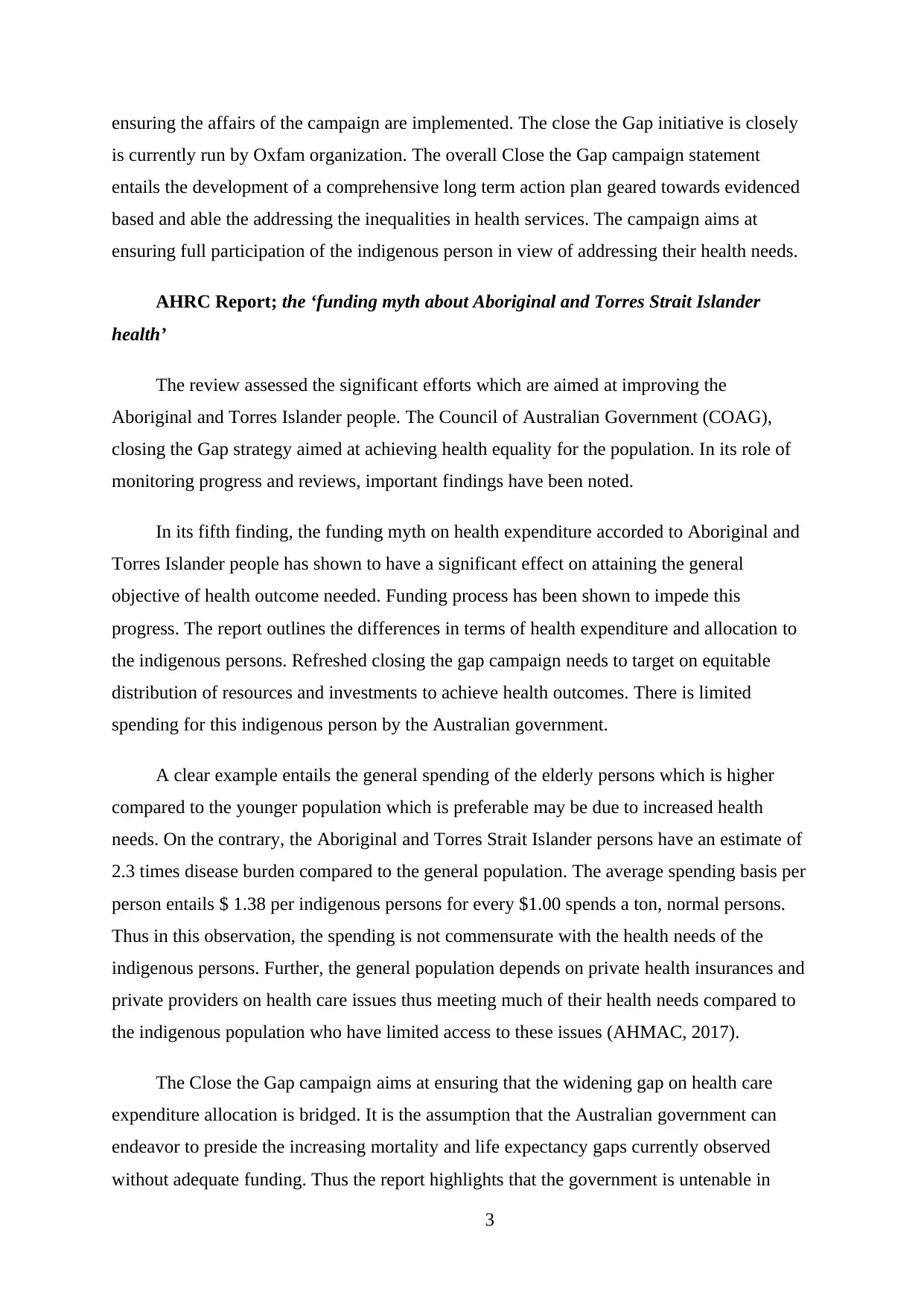
ensuring the affairs of the campaign are implemented. The close the Gap initiative is closely
is currently run by Oxfam organization. The overall Close the Gap campaign statement
entails the development of a comprehensive long term action plan geared towards evidenced
based and able the addressing the inequalities in health services. The campaign aims at
ensuring full participation of the indigenous person in view of addressing their health needs.
AHRC Report; the ‘funding myth about Aboriginal and Torres Strait Islander
health’
The review assessed the significant efforts which are aimed at improving the
Aboriginal and Torres Islander people. The Council of Australian Government (COAG),
closing the Gap strategy aimed at achieving health equality for the population. In its role of
monitoring progress and reviews, important findings have been noted.
In its fifth finding, the funding myth on health expenditure accorded to Aboriginal and
Torres Islander people has shown to have a significant effect on attaining the general
objective of health outcome needed. Funding process has been shown to impede this
progress. The report outlines the differences in terms of health expenditure and allocation to
the indigenous persons. Refreshed closing the gap campaign needs to target on equitable
distribution of resources and investments to achieve health outcomes. There is limited
spending for this indigenous person by the Australian government.
A clear example entails the general spending of the elderly persons which is higher
compared to the younger population which is preferable may be due to increased health
needs. On the contrary, the Aboriginal and Torres Strait Islander persons have an estimate of
2.3 times disease burden compared to the general population. The average spending basis per
person entails $ 1.38 per indigenous persons for every $1.00 spends a ton, normal persons.
Thus in this observation, the spending is not commensurate with the health needs of the
indigenous persons. Further, the general population depends on private health insurances and
private providers on health care issues thus meeting much of their health needs compared to
the indigenous population who have limited access to these issues (AHMAC, 2017).
The Close the Gap campaign aims at ensuring that the widening gap on health care
expenditure allocation is bridged. It is the assumption that the Australian government can
endeavor to preside the increasing mortality and life expectancy gaps currently observed
without adequate funding. Thus the report highlights that the government is untenable in
3
is currently run by Oxfam organization. The overall Close the Gap campaign statement
entails the development of a comprehensive long term action plan geared towards evidenced
based and able the addressing the inequalities in health services. The campaign aims at
ensuring full participation of the indigenous person in view of addressing their health needs.
AHRC Report; the ‘funding myth about Aboriginal and Torres Strait Islander
health’
The review assessed the significant efforts which are aimed at improving the
Aboriginal and Torres Islander people. The Council of Australian Government (COAG),
closing the Gap strategy aimed at achieving health equality for the population. In its role of
monitoring progress and reviews, important findings have been noted.
In its fifth finding, the funding myth on health expenditure accorded to Aboriginal and
Torres Islander people has shown to have a significant effect on attaining the general
objective of health outcome needed. Funding process has been shown to impede this
progress. The report outlines the differences in terms of health expenditure and allocation to
the indigenous persons. Refreshed closing the gap campaign needs to target on equitable
distribution of resources and investments to achieve health outcomes. There is limited
spending for this indigenous person by the Australian government.
A clear example entails the general spending of the elderly persons which is higher
compared to the younger population which is preferable may be due to increased health
needs. On the contrary, the Aboriginal and Torres Strait Islander persons have an estimate of
2.3 times disease burden compared to the general population. The average spending basis per
person entails $ 1.38 per indigenous persons for every $1.00 spends a ton, normal persons.
Thus in this observation, the spending is not commensurate with the health needs of the
indigenous persons. Further, the general population depends on private health insurances and
private providers on health care issues thus meeting much of their health needs compared to
the indigenous population who have limited access to these issues (AHMAC, 2017).
The Close the Gap campaign aims at ensuring that the widening gap on health care
expenditure allocation is bridged. It is the assumption that the Australian government can
endeavor to preside the increasing mortality and life expectancy gaps currently observed
without adequate funding. Thus the report highlights that the government is untenable in
3
⊘ This is a preview!⊘
Do you want full access?
Subscribe today to unlock all pages.

Trusted by 1+ million students worldwide
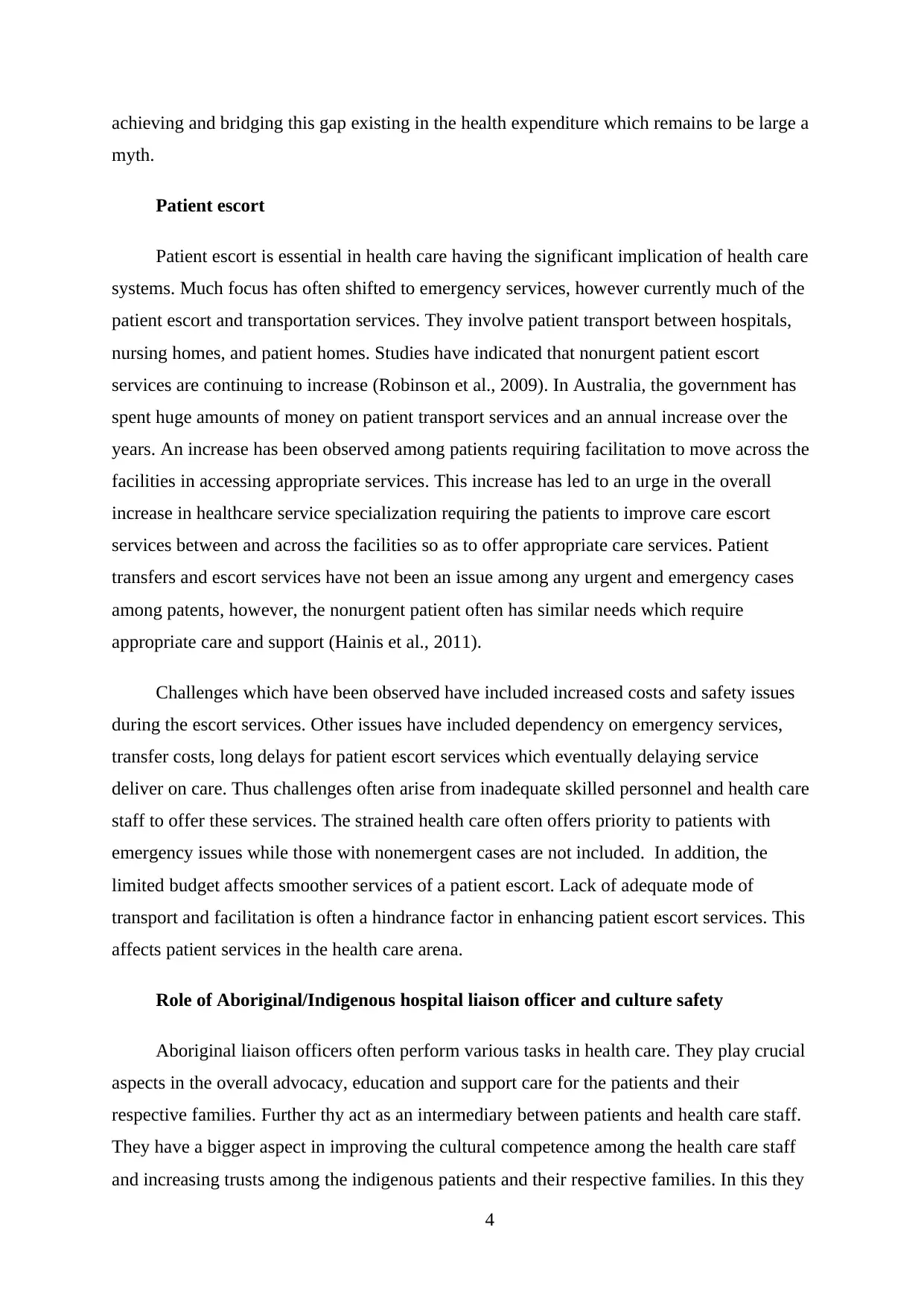
achieving and bridging this gap existing in the health expenditure which remains to be large a
myth.
Patient escort
Patient escort is essential in health care having the significant implication of health care
systems. Much focus has often shifted to emergency services, however currently much of the
patient escort and transportation services. They involve patient transport between hospitals,
nursing homes, and patient homes. Studies have indicated that nonurgent patient escort
services are continuing to increase (Robinson et al., 2009). In Australia, the government has
spent huge amounts of money on patient transport services and an annual increase over the
years. An increase has been observed among patients requiring facilitation to move across the
facilities in accessing appropriate services. This increase has led to an urge in the overall
increase in healthcare service specialization requiring the patients to improve care escort
services between and across the facilities so as to offer appropriate care services. Patient
transfers and escort services have not been an issue among any urgent and emergency cases
among patents, however, the nonurgent patient often has similar needs which require
appropriate care and support (Hainis et al., 2011).
Challenges which have been observed have included increased costs and safety issues
during the escort services. Other issues have included dependency on emergency services,
transfer costs, long delays for patient escort services which eventually delaying service
deliver on care. Thus challenges often arise from inadequate skilled personnel and health care
staff to offer these services. The strained health care often offers priority to patients with
emergency issues while those with nonemergent cases are not included. In addition, the
limited budget affects smoother services of a patient escort. Lack of adequate mode of
transport and facilitation is often a hindrance factor in enhancing patient escort services. This
affects patient services in the health care arena.
Role of Aboriginal/Indigenous hospital liaison officer and culture safety
Aboriginal liaison officers often perform various tasks in health care. They play crucial
aspects in the overall advocacy, education and support care for the patients and their
respective families. Further thy act as an intermediary between patients and health care staff.
They have a bigger aspect in improving the cultural competence among the health care staff
and increasing trusts among the indigenous patients and their respective families. In this they
4
myth.
Patient escort
Patient escort is essential in health care having the significant implication of health care
systems. Much focus has often shifted to emergency services, however currently much of the
patient escort and transportation services. They involve patient transport between hospitals,
nursing homes, and patient homes. Studies have indicated that nonurgent patient escort
services are continuing to increase (Robinson et al., 2009). In Australia, the government has
spent huge amounts of money on patient transport services and an annual increase over the
years. An increase has been observed among patients requiring facilitation to move across the
facilities in accessing appropriate services. This increase has led to an urge in the overall
increase in healthcare service specialization requiring the patients to improve care escort
services between and across the facilities so as to offer appropriate care services. Patient
transfers and escort services have not been an issue among any urgent and emergency cases
among patents, however, the nonurgent patient often has similar needs which require
appropriate care and support (Hainis et al., 2011).
Challenges which have been observed have included increased costs and safety issues
during the escort services. Other issues have included dependency on emergency services,
transfer costs, long delays for patient escort services which eventually delaying service
deliver on care. Thus challenges often arise from inadequate skilled personnel and health care
staff to offer these services. The strained health care often offers priority to patients with
emergency issues while those with nonemergent cases are not included. In addition, the
limited budget affects smoother services of a patient escort. Lack of adequate mode of
transport and facilitation is often a hindrance factor in enhancing patient escort services. This
affects patient services in the health care arena.
Role of Aboriginal/Indigenous hospital liaison officer and culture safety
Aboriginal liaison officers often perform various tasks in health care. They play crucial
aspects in the overall advocacy, education and support care for the patients and their
respective families. Further thy act as an intermediary between patients and health care staff.
They have a bigger aspect in improving the cultural competence among the health care staff
and increasing trusts among the indigenous patients and their respective families. In this they
4
Paraphrase This Document
Need a fresh take? Get an instant paraphrase of this document with our AI Paraphraser
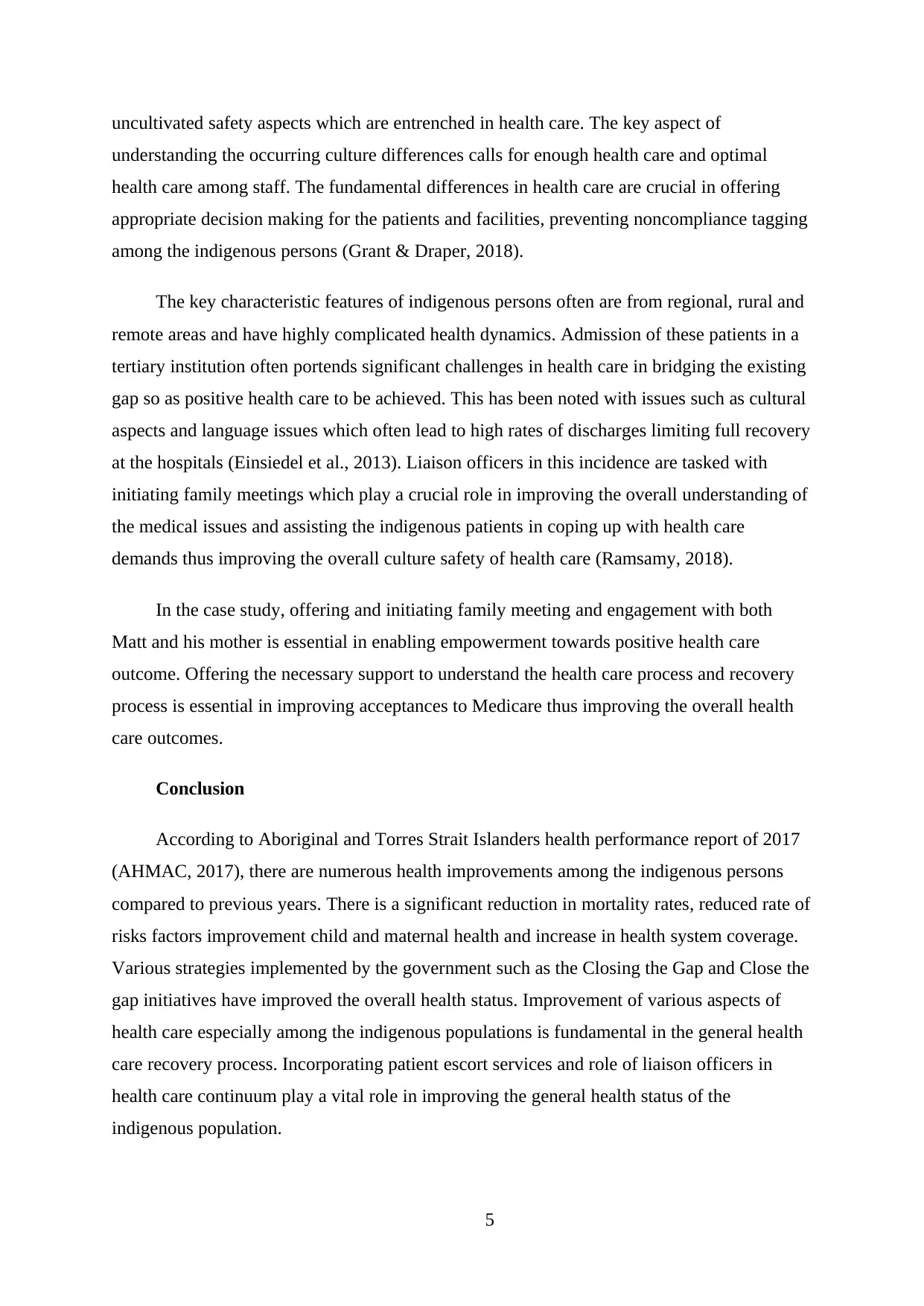
uncultivated safety aspects which are entrenched in health care. The key aspect of
understanding the occurring culture differences calls for enough health care and optimal
health care among staff. The fundamental differences in health care are crucial in offering
appropriate decision making for the patients and facilities, preventing noncompliance tagging
among the indigenous persons (Grant & Draper, 2018).
The key characteristic features of indigenous persons often are from regional, rural and
remote areas and have highly complicated health dynamics. Admission of these patients in a
tertiary institution often portends significant challenges in health care in bridging the existing
gap so as positive health care to be achieved. This has been noted with issues such as cultural
aspects and language issues which often lead to high rates of discharges limiting full recovery
at the hospitals (Einsiedel et al., 2013). Liaison officers in this incidence are tasked with
initiating family meetings which play a crucial role in improving the overall understanding of
the medical issues and assisting the indigenous patients in coping up with health care
demands thus improving the overall culture safety of health care (Ramsamy, 2018).
In the case study, offering and initiating family meeting and engagement with both
Matt and his mother is essential in enabling empowerment towards positive health care
outcome. Offering the necessary support to understand the health care process and recovery
process is essential in improving acceptances to Medicare thus improving the overall health
care outcomes.
Conclusion
According to Aboriginal and Torres Strait Islanders health performance report of 2017
(AHMAC, 2017), there are numerous health improvements among the indigenous persons
compared to previous years. There is a significant reduction in mortality rates, reduced rate of
risks factors improvement child and maternal health and increase in health system coverage.
Various strategies implemented by the government such as the Closing the Gap and Close the
gap initiatives have improved the overall health status. Improvement of various aspects of
health care especially among the indigenous populations is fundamental in the general health
care recovery process. Incorporating patient escort services and role of liaison officers in
health care continuum play a vital role in improving the general health status of the
indigenous population.
5
understanding the occurring culture differences calls for enough health care and optimal
health care among staff. The fundamental differences in health care are crucial in offering
appropriate decision making for the patients and facilities, preventing noncompliance tagging
among the indigenous persons (Grant & Draper, 2018).
The key characteristic features of indigenous persons often are from regional, rural and
remote areas and have highly complicated health dynamics. Admission of these patients in a
tertiary institution often portends significant challenges in health care in bridging the existing
gap so as positive health care to be achieved. This has been noted with issues such as cultural
aspects and language issues which often lead to high rates of discharges limiting full recovery
at the hospitals (Einsiedel et al., 2013). Liaison officers in this incidence are tasked with
initiating family meetings which play a crucial role in improving the overall understanding of
the medical issues and assisting the indigenous patients in coping up with health care
demands thus improving the overall culture safety of health care (Ramsamy, 2018).
In the case study, offering and initiating family meeting and engagement with both
Matt and his mother is essential in enabling empowerment towards positive health care
outcome. Offering the necessary support to understand the health care process and recovery
process is essential in improving acceptances to Medicare thus improving the overall health
care outcomes.
Conclusion
According to Aboriginal and Torres Strait Islanders health performance report of 2017
(AHMAC, 2017), there are numerous health improvements among the indigenous persons
compared to previous years. There is a significant reduction in mortality rates, reduced rate of
risks factors improvement child and maternal health and increase in health system coverage.
Various strategies implemented by the government such as the Closing the Gap and Close the
gap initiatives have improved the overall health status. Improvement of various aspects of
health care especially among the indigenous populations is fundamental in the general health
care recovery process. Incorporating patient escort services and role of liaison officers in
health care continuum play a vital role in improving the general health status of the
indigenous population.
5
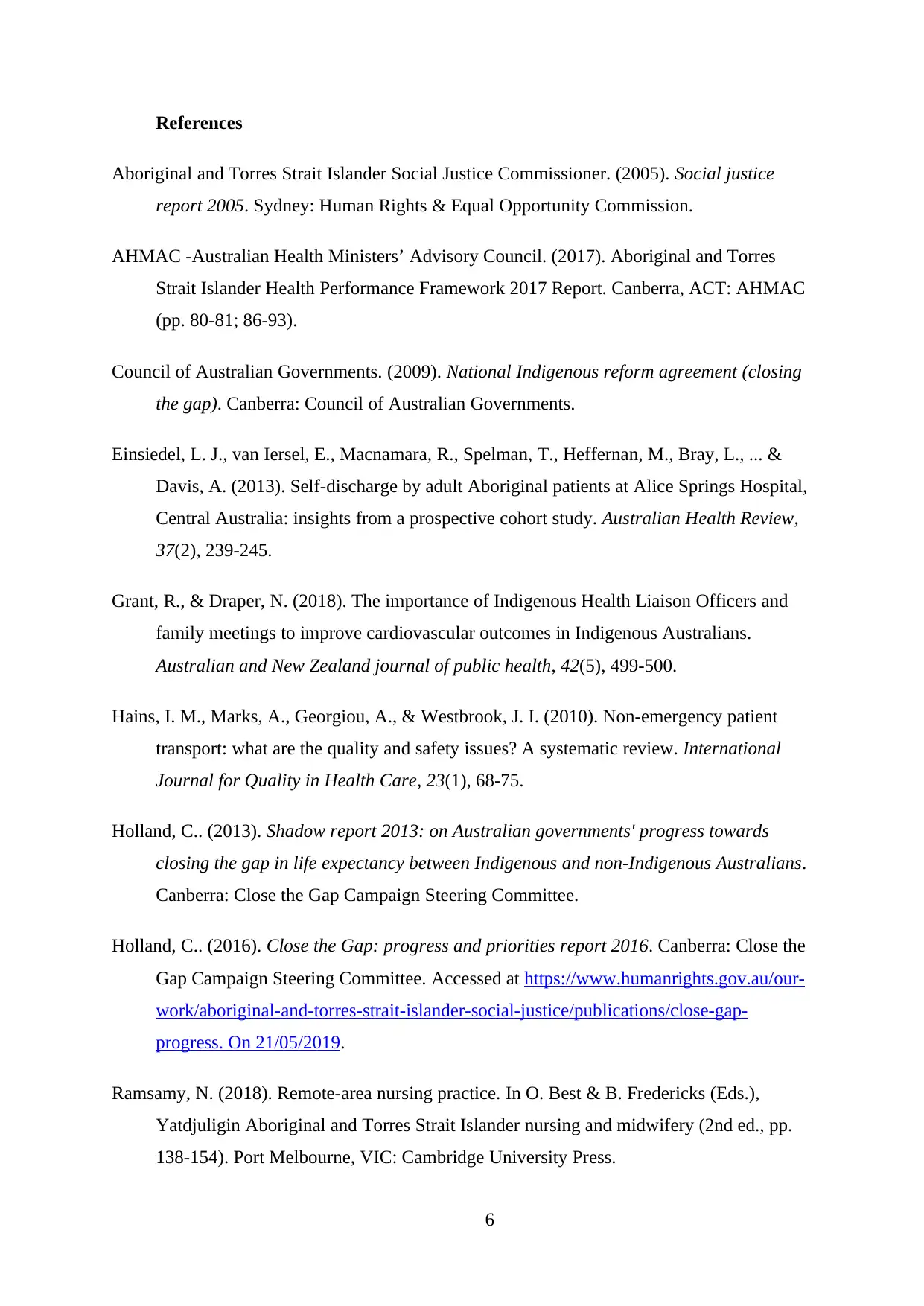
References
Aboriginal and Torres Strait Islander Social Justice Commissioner. (2005). Social justice
report 2005. Sydney: Human Rights & Equal Opportunity Commission.
AHMAC -Australian Health Ministers’ Advisory Council. (2017). Aboriginal and Torres
Strait Islander Health Performance Framework 2017 Report. Canberra, ACT: AHMAC
(pp. 80-81; 86-93).
Council of Australian Governments. (2009). National Indigenous reform agreement (closing
the gap). Canberra: Council of Australian Governments.
Einsiedel, L. J., van Iersel, E., Macnamara, R., Spelman, T., Heffernan, M., Bray, L., ... &
Davis, A. (2013). Self-discharge by adult Aboriginal patients at Alice Springs Hospital,
Central Australia: insights from a prospective cohort study. Australian Health Review,
37(2), 239-245.
Grant, R., & Draper, N. (2018). The importance of Indigenous Health Liaison Officers and
family meetings to improve cardiovascular outcomes in Indigenous Australians.
Australian and New Zealand journal of public health, 42(5), 499-500.
Hains, I. M., Marks, A., Georgiou, A., & Westbrook, J. I. (2010). Non-emergency patient
transport: what are the quality and safety issues? A systematic review. International
Journal for Quality in Health Care, 23(1), 68-75.
Holland, C.. (2013). Shadow report 2013: on Australian governments' progress towards
closing the gap in life expectancy between Indigenous and non-Indigenous Australians.
Canberra: Close the Gap Campaign Steering Committee.
Holland, C.. (2016). Close the Gap: progress and priorities report 2016. Canberra: Close the
Gap Campaign Steering Committee. Accessed at https://www.humanrights.gov.au/our-
work/aboriginal-and-torres-strait-islander-social-justice/publications/close-gap-
progress. On 21/05/2019.
Ramsamy, N. (2018). Remote-area nursing practice. In O. Best & B. Fredericks (Eds.),
Yatdjuligin Aboriginal and Torres Strait Islander nursing and midwifery (2nd ed., pp.
138-154). Port Melbourne, VIC: Cambridge University Press.
6
Aboriginal and Torres Strait Islander Social Justice Commissioner. (2005). Social justice
report 2005. Sydney: Human Rights & Equal Opportunity Commission.
AHMAC -Australian Health Ministers’ Advisory Council. (2017). Aboriginal and Torres
Strait Islander Health Performance Framework 2017 Report. Canberra, ACT: AHMAC
(pp. 80-81; 86-93).
Council of Australian Governments. (2009). National Indigenous reform agreement (closing
the gap). Canberra: Council of Australian Governments.
Einsiedel, L. J., van Iersel, E., Macnamara, R., Spelman, T., Heffernan, M., Bray, L., ... &
Davis, A. (2013). Self-discharge by adult Aboriginal patients at Alice Springs Hospital,
Central Australia: insights from a prospective cohort study. Australian Health Review,
37(2), 239-245.
Grant, R., & Draper, N. (2018). The importance of Indigenous Health Liaison Officers and
family meetings to improve cardiovascular outcomes in Indigenous Australians.
Australian and New Zealand journal of public health, 42(5), 499-500.
Hains, I. M., Marks, A., Georgiou, A., & Westbrook, J. I. (2010). Non-emergency patient
transport: what are the quality and safety issues? A systematic review. International
Journal for Quality in Health Care, 23(1), 68-75.
Holland, C.. (2013). Shadow report 2013: on Australian governments' progress towards
closing the gap in life expectancy between Indigenous and non-Indigenous Australians.
Canberra: Close the Gap Campaign Steering Committee.
Holland, C.. (2016). Close the Gap: progress and priorities report 2016. Canberra: Close the
Gap Campaign Steering Committee. Accessed at https://www.humanrights.gov.au/our-
work/aboriginal-and-torres-strait-islander-social-justice/publications/close-gap-
progress. On 21/05/2019.
Ramsamy, N. (2018). Remote-area nursing practice. In O. Best & B. Fredericks (Eds.),
Yatdjuligin Aboriginal and Torres Strait Islander nursing and midwifery (2nd ed., pp.
138-154). Port Melbourne, VIC: Cambridge University Press.
6
⊘ This is a preview!⊘
Do you want full access?
Subscribe today to unlock all pages.

Trusted by 1+ million students worldwide
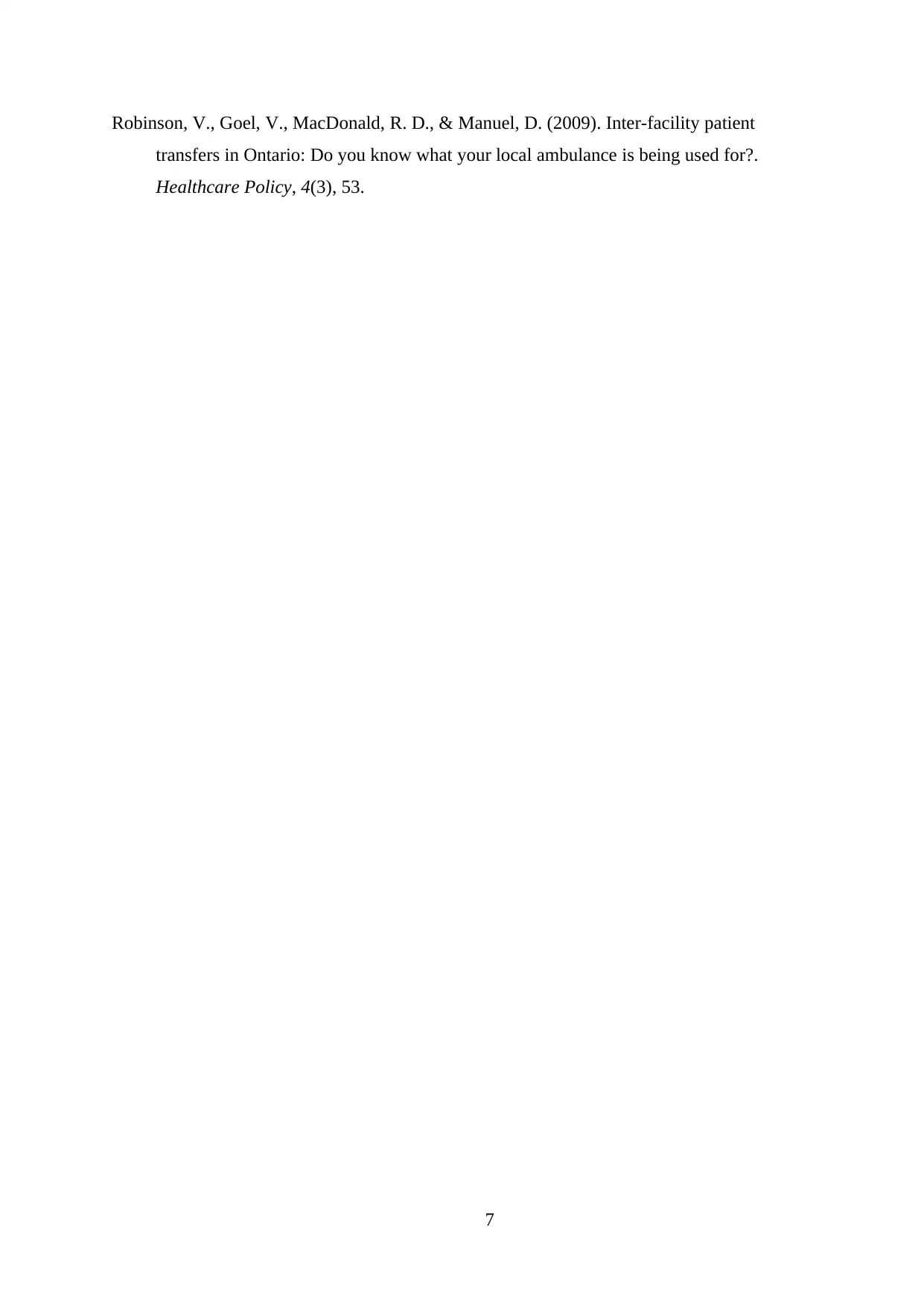
Robinson, V., Goel, V., MacDonald, R. D., & Manuel, D. (2009). Inter-facility patient
transfers in Ontario: Do you know what your local ambulance is being used for?.
Healthcare Policy, 4(3), 53.
7
transfers in Ontario: Do you know what your local ambulance is being used for?.
Healthcare Policy, 4(3), 53.
7
1 out of 7
Related Documents
Your All-in-One AI-Powered Toolkit for Academic Success.
+13062052269
info@desklib.com
Available 24*7 on WhatsApp / Email
![[object Object]](/_next/static/media/star-bottom.7253800d.svg)
Unlock your academic potential
Copyright © 2020–2025 A2Z Services. All Rights Reserved. Developed and managed by ZUCOL.




